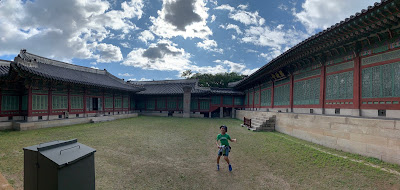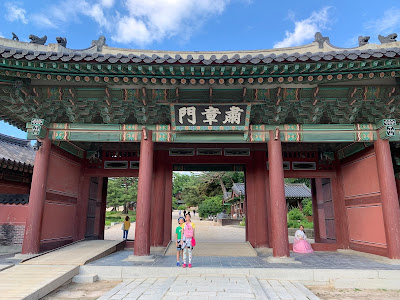Changdeokgung Palace was the second royal villa built following the construction of Gyeongbukgung Palace in 1405. It was the principal palace for many kings of the Joseon Dynasty, and is the most well-preserved of the five remaining royal Joseon palaces. The palace grounds are comprised of a public palace area, a royal family residence building, and the rear garden. Known as a place of rest for the kings, the rear garden boasts a gigantic tree that is over 300 years old, a small pond and a pavilion.
Throughout the visit, we saw many people wearing Hanbok (traditional Korean clothes). The reason is that it is free admission for those wearing a Hanbok.
Injeongmun Gate (仁政门) is the main gate leading into Changdeokgung Palace and its courtyard where Injeongjeon Hall (仁政殿) is located.
With a name meaning “benevolent rule,” Injeonjeon Hall was used for matters relating to the king’s ruling of the nation, and was used for conducting state affairs, including the coronation of a new king and prince, and royal weddings. Therefore this hall is by far the most important of all the buildings in Changdeokgung Palace.
Following shows the interior of Injeongjeon Hall, which is the throne hall where kings and their ministers discussed state affairs to effectively reign over the people.
Changdeokgung Palace was built in 1405 by King Taejong, the third ruler of Joseon. All palaces in Seoul were burnt down during the Japanese invasion in 1592 and Changdeokgung Palace became the first palace to be rebuilt in 1610. Since then, it became the primary palace for about 270 years where 13 kings including the last monarch dealt with state affairs.
Seonjeongjeon Hall (宣政门) is the ruler's council hall and the only structure remaining at Changdeokgung palace with blue-glazed roof tiles.
Here the king worked at his convenience to discuss state affairs with high-ranking officials. It was built to the east of the Throne Hall. Various assemblies including daily morning meetings, reports of national affairs and state seminars were held here. A narrow colonnaded area surrounding the hall was used as offices for secretaries and storage. Seonjeongjeon Hall once served as a royal shrine during royal funerals, and the corridor provides the only remaining evidence of its funerary function.
Huijeongdang Hall (熙政堂) served as an office for the king and also his bedchamber. It was destroyed by fire in 1917, and the current building was rebuilt in 1920 with materials taken from the king's residence at Geongbokgung Palace. As a result, the reconstructed Huijeongdang is very different from the original.In the front is a driveway for cars, and the interior is outfitted with Western furnishings, such as glass windows and electric lighting.
Daejojeon Hall was the residence for the king and queen, and contained separate floor-heated ondol rooms for the king and the queen, and a gathering hall in between. Royal banquets were also held here. This building was witness to a great tragedy as it was here that the Joseon Dynasty held its last cabinet meeting to deliberate on the annexation of Korea by Japan.
Annex buildings are connected by colonnaded corridors. Similar to Huijeongdang, when Daejojeong was destroyed by fire in 1917, the existing building was reconstructed with materials removed from the queen's quarters at Gyeongbokgung Palace. It was used as a residence for the last empress of Joseon until after the liberation of Korea.
The decorations, murals and the frame of sliding paper door remain in good condition.Daejojeon Hall was built with Western features, including a narrow wooden veranda, glass windows, and furniture. This modern interior design makes Daejojeon Hall unique among palace buildings.
At the rear of the hall is an elevated floor from which a four-terraced garden can be viewed.
In 1847, King Heonjong constructed Nakseonjae as his library and living quarters, when he received a concubine because Queen Hyojeong failed to bear a son. The following year, the king constructed two more buildings to the east of Nakseonjae; Seokbokheon, the residence of his concubine Gyeongbin, and Sugangjae, the residence of Queen dowager Sunwon after her regency came to an end upon King Heonjong's marriage. King Heonjong ordered these residences to be built in a modest style without the vibrant traditional paintwork called dancheong normally used on royal residences.
Javier looking into a well right outside the Nakseonjae Complex.
At this point, we took a short break at the rest room before walking back to the palace exit as this place was going to closed for the day.
The royal (secret or Huwon) garden is located in the northern section of Changdeokgung Palace but we did not manage to catch the guided tour. Serving in various ways depending on the circumstances, Huwon Garden was most often used as a resting space for the king. The garden is home to trees planted hundreds of years ago, and small pavilions and fountains complete the traditional Korean style garden. In order to preserve the historical integrity of the Huwon, visitors must sign-up for a guided palace tour in advance.
We continued to explore two more areas, namely Gwolnaegaksa and Seonwonjeon, in the palace compound before leaving this UNESCO World Heritage Site.














































No comments:
Post a Comment